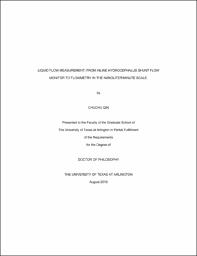
ATTENTION: The works hosted here are being migrated to a new repository that will consolidate resources, improve discoverability, and better show UTA's research impact on the global community. We will update authors as the migration progresses. Please see MavMatrix for more information.
Show simple item record
| dc.contributor.advisor | Dasgupta, Purnendu K | |
| dc.creator | Qin, Chuchu | |
| dc.date.accessioned | 2020-08-04T17:30:04Z | |
| dc.date.available | 2020-08-04T17:30:04Z | |
| dc.date.created | 2019-08 | |
| dc.date.issued | 2019-08-13 | |
| dc.date.submitted | August 2019 | |
| dc.identifier.uri | http://hdl.handle.net/10106/29307 | |
| dc.description.abstract | This dissertation primarily focuses on designing and developing novel sensing strategies and instruments for ultra-low liquid flow measurement.
An inline thermal flow sensor based on a single common thermistor has been developed to quantitatively measures cerebral spinal fluid flow rate in hydrocephalus shunt. The technique facilitates the diagnosis of shunt failure due to blockage or over-drainage. This allows timely remediation of shunt-flow malfunctions, thereby avoiding severe complications that can arise.
The thermal flow sensor utilizes the bidirectional ability of the thermistor to both heat the surrounding and to sense the temperature. The net temperature change from immediately before and after the heat pulse, along with the surrounding temperature was used to predict the flow rate between 0-52.5 mL/h at 32-39 ˚C with 6.3% RMS relative error. The functionality of the flow monitor has been verified on a healthy pig model. Six of eight tests with experimental pigs were successfully conducted with > 4300 acceptable flow measurements. Very good correlation was observed between measured and predicted flow rates (r > 0.9). The average slope of measured vs predicted flow rates was 1.04 ± 0.15, indicating that the flow monitor accurately measured porcine CSF flow.
Precise flowmetry is essential for the overall reliability and integrity of analytical systems. Nowadays, many capillary scale analytical approaches operate at flow rates below 25 nL/min. At this level, any leak evaporates long before it is visible. An affordable monitor applicable in this flow regime can greatly facilitate instrument/method development as well as help troubleshoot processes that operate in this flow scale.
Thus, we developed a flow measurement technique works in the 1.5-15 nL/min flow range with good precision (<1% RSD). The motion of a conductive/nonconductive immiscible segmental interface in a capillary is followed by an admittance detector in a fluorosilylated fused silica capillary flow cell. A four-port valve was used to change the flow direction in the flow cell so that flow marker moves back-and-forth across the admittance detector, triggers a series of flow analysis. Three flow-depended features were studied, each providing good linear relationships with flow rate (R^2 > 0.995). The useful range of flow rate can easily be changed if needed, simply by using a larger or smaller inner diameter fused silica capillary as a flow cell. In a single capillary, the measurement range can be widened by introducing multiple different length conductive liquid segments segregated by fluorocarbon. | |
| dc.format.mimetype | application/pdf | |
| dc.language.iso | en_US | |
| dc.subject | Hydrocephalus | |
| dc.subject | Ventriculoperitoneal shunt | |
| dc.subject | Flow sensor | |
| dc.subject | Bidirectional thermal transducer | |
| dc.subject | Time of flight | |
| dc.subject | Time of sight | |
| dc.subject | Nanoliter per minute liquid flow measurement. | |
| dc.title | LIQUID FLOW MEASUREMENT: FROM INLINE HYDROCEPHALUS SHUNT FLOW MONITOR TO FLOWMETRY IN THE NANOLITER/MINUTE SCALE | |
| dc.type | Thesis | |
| dc.degree.department | Chemistry and Biochemistry | |
| dc.degree.name | Doctor of Philosophy in Chemistry | |
| dc.date.updated | 2020-08-04T17:30:04Z | |
| thesis.degree.department | Chemistry and Biochemistry | |
| thesis.degree.grantor | The University of Texas at Arlington | |
| thesis.degree.level | Doctoral | |
| thesis.degree.name | Doctor of Philosophy in Chemistry | |
| dc.type.material | text | |
Files in this item
- Name:
- QIN-DISSERTATION-2019.pdf
- Size:
- 6.211Mb
- Format:
- PDF
This item appears in the following Collection(s)
Show simple item record


